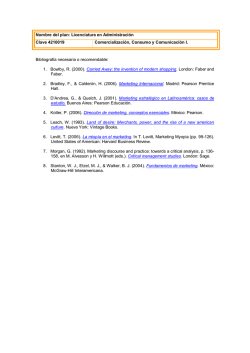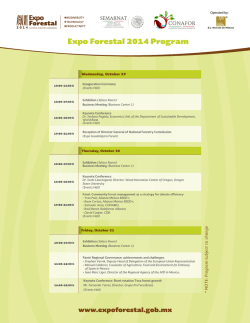
Predation of nestling house finches (Haemorhous mexicanus) by a
Available online at www.sciencedirect.com Revista Mexicana de Biodiversidad Revista Mexicana de Biodiversidad 86 (2015) 550–552 www.ib.unam.mx/revista/ Research note Predation of nestling house finches (Haemorhous mexicanus) by a dusky rattlesnake, Crotalus aquilus, in Hidalgo, Mexico Depredación de pollos del gorrión mexicano (Haemorhous mexicanus) por la serpiente de cascabel, Crotalus aquilus, en Hidalgo, México Fanny Rebón-Gallardo, Oscar Flores-Villela ∗ , David R. Ortíz-Ramírez Museo de Zoología, Facultad de Ciencias, Universidad Nacional Autónoma de México, Apartado postal 70-399, 04510 México D.F., Mexico Received 9 April 2013; accepted 2 December 2014 Available online 21 May 2015 Abstract For the first time, a case of predation on a Haemorhous mexicanus nest by the dusky rattlesnake Crotalus aquilus is presented. The phenomenon of gluttony by this rattlesnake, which may have caused the death of the snake is also documented; since it had already eaten an adult Peromyscus maniculatus before consuming the 4 chicks in the nest. All Rights Reserved © 2015 Universidad Nacional Autónoma de México, Instituto de Biología. This is an open access item distributed under the Creative Commons CC License BY-NC-ND 4.0. Keywords: Feeding; Gluttony; Predation; Viperidae; Fringillidae; Pygmy rattlesnakes; Montane rattlesnakes; Mexico Resumen Se presenta por primera vez un caso de depredación de un nido de Haemorhous mexicanus por una cascabel Crotalus aquilus. Con este caso también se documenta el fenómeno de glotonería por parte de la serpiente de cascabel; mismo que le pudo haber provocado la muerte, pues además de haberse comido los 4 pollos del nido ya tenía en su estómago un adulto del roedor Peromyscus maniculatus. Derechos Reservados © 2015 Universidad Nacional Autónoma de México, Instituto de Biología. Este es un artículo de acceso abierto distribuido bajo los términos de la Licencia Creative Commons CC BY-NC-ND 4.0. Palabras clave: Alimentación; Glotonería; Depredación; Viperidae; Fringillidae; Serpientes de cascabel enanas; Serpientes de cascabel de montaña; México Haemorhous mexicanus (Aves: Fringillidae) is distributed from western Canada and the United States to Mexico and was introduced in the Hawaiian Islands and the northeastern United States in 1940 (AOU, 1998). In Mexico, H. mexicanus is a resident species, which has been recorded throughout most of the country, except for the coast of the Gulf of Mexico and the Pacific coast of the state of Nayarit. It has also recently been introduced in the highlands of Chiapas owing to demand for the species as a pet (Howell & Webb, 1995; Peterson & Chalif, 2008). H. mexicanus lives in a variety of habitats: open coniferous forest, deserts near water, desert scrub, open and semi-open arid ∗ Corresponding author. E-mail address: [email protected] (O. Flores-Villela). Peer Review under the responsibility of Universidad Nacional Autónoma de México. vegetation, pine-oak forest, riparian vegetation, coastal zones, and canyons; it is found up to an elevation of 3,500 masl (Hill, 2012). This bird is commonly found in disturbed areas close to human settlements, but is absent from dense coniferous and deciduous forests far from inhabited areas (Hill, 2012). The house finch usually nests in colonies, but there are reports of solitary nesting (Hill, 2012). This is an abundant and highly opportunistic species utilizing human settlements for feeding, shelter and nesting; its females can reproduce during their first year of life (Bent, 1968; Hill, 2012; Nocedal, 2011). It is abundant where it occurs and nests near human constructions, therefore it may be safe from some wild predators (Bent, 1968). The most common predators of H. mexicanus are domestic animals, such as cats and dogs. Mortality may also result from epidemic diseases, such as Mycoplasma gallisepticum, a disease that has affected domestic poultry in the http://dx.doi.org/10.1016/j.rmb.2015.04.001 1870-3453/All Rights Reserved © 2015 Universidad Nacional Autónoma de México, Instituto de Biología. This is an open access item distributed under the Creative Commons CC License BY-NC-ND 4.0. F. Rebón-Gallardo et al. / Revista Mexicana de Biodiversidad 86 (2015) 550–552 Figure 1. House finch, Haemorhous mexicanus, chicks eaten by a dusky rattlesnake, Crotalus aquilus. (A) Ventral view, (B) dorsal view, (C) close-up of one chick’s head, (D) close-up of a wing. eastern United States since 1994 (Nocedal, 2011). Interactions have been recorded with the House Sparrow (Passer domesticus), which invades the nests of H. mexicanus and is dominant wherever both species feed (Nocedal, 2011). On July 14, 2010 a dusky rattlesnake (Crotalus aquilus, MZFC 25,093; female, total length: 58 cm; snout-vent length: 52 cm) was found at Rancho Santa Elena, Huasca de Ocampo, Hidalgo, Mexico (20◦ 8 17.19 N, 98◦ 30 13.58 W, 2,404 masl). The snake was in the process of dying and upon examination, it regurgitated 4 chicks that were later examined and identified as H. mexicanus (Fig. 1A–D). When the snake was found, it showed no symptoms or signs of being beaten or run over by a car, and it was brought to us in good condition, but already preserved in 70% ethanol. The chicks were identified by comparison of plumage with preserved skins. Bill, wing chord, and tarsus measurements were taken (Table 1). After consultation of current literature (Howell & Webb, 1995) and a list of local species (García-Trejo, pers. com.), we confirmed the presence of this species in the locality. 551 We determined that the chicks were approximately 12–14 days old; according to Hill (1993) at 10 days old the culmen in this species is 4–8 mm (the average for the 4 chicks was 7.48 mm) and mouth width is 5.5–11.0 mm (average: 6.14 mm). Tarsus length averaged 17.13 mm, the length of an adult tarsus. According to Bent (1968), H. mexicanus chicks stay in the nest for 14–16 days after hatching, and, at 12–14 days of age, are completely feathered though not yet able to fly due to the long sheaths on their wing feathers (Fig. 1D). Only 1 chick showed any evidence of digestion on the head part (Fig. 1B, third from left to right). Rattlesnakes are primarily ground-dwelling predators, thus it is likely that the nest was situated on the ground or very close to it. However, one of us (OFV) had previously observed a closely related species of rattlesnake (Crotalus triseriatus) sitting on a log about 1 m above ground at Lagunas de Zempoala National Park, Morelos, Mexico. These 2 species are very similar in size and habit, so we cannot discard the possibility that C. aquilus was able to reach a nest above ground level. Bent (1968), reports that house finches occasionally nest on the ground, inside abandoned rabbit holes, and in human constructions. Rattlesnakes (Crotalus and Sistrurus spp.) are known to occasionally prey upon birds. The rattlesnake species that most frequently preys upon birds inhabits places where ground nesting bird species are present (Klauber, 1972). This is true for Crotalus pricei (twin-spotted rattlesnake), preying on Junco phaeonotus (Yellow-eyed Junco), for which this snake may be a significant nest predator (Gumbart & Sullivan, 1990). However, there are no records of dusky rattlesnakes preying on birds (Campbell & Lamar, 2004; Klauber, 1972; Rubio, 1998). The snake was dissected as it still appeared swollen after regurgitating the chicks, and we thought an adult bird might also have been ingested, and that identifying it would help us identify the chicks. Instead, we found a partially digested juvenile mouse (Peromyscus maniculatus). The mouse was identified by hair clearing (Arita & Aranda, 1987) and by comparison with the illustration in Monroy-Vilchis and Rubio-Rodríguez (2001). It seems bizarre that a dusky rattlesnake would prey on birds, since it usually feeds on lizards, small mammals, and other snakes (Campbell & Lamar, 2004; Mociño-Deloya, Setser, Peurach, & Meik, 2008; Rubio, 1998). Klauber (1972) recorded lizards as the predominant item in the diet of C. lepidus, sister taxon to C. aquilus (Bryson, Murphy, Lathrop, & LazcanoVillareal, 2011), though Klauber recorded the stomach contents of one C. lepidus as containing a bird (not identified by Klauber). Armstrong and Murphy (1979) recorded nocturnal feeding in this species; however, in this case the chicks may have been eaten during the day since the parents did not seem to be guarding the nest and the snake had enough time to consume all 4 chicks, and showed no signs of any kind of attack. Having eaten the mouse days before, the amount of food that the snake consumed may be what caused its death. There are few records of overeating in snakes. For example, Mulcahy, Mendelson III, Setser, and Hollenbeck (2003) reported a Crotalus cerastes eating a large tiger whiptail (Aspidoscelis tigris), that may have caused the death of the snake; Rodríguez-Robles (2002) recorded 2 cases of the gopher snake, Pituophis catenifer, eating prey with 81.8 552 F. Rebón-Gallardo et al. / Revista Mexicana de Biodiversidad 86 (2015) 550–552 Table 1 Meristic data for Haemorhous mexicanus chicks regurgitated by a Crotalus aquilus in Hidalgo, Mexico. Chick 1 Chick 2 Chick 3 Chick 4 Catalog number Weight Culmen Bill width Height Wing chord Tarsus MZFC 23839 MZFC 23840 MZFC 23841 MZFC 23842 Average 12 g 13 g 11 g 10 g 11.5 7.64 7.80 7.57 6.91 7.48 6.17 6.49 6.03 5.88 6.14 5.57 5.61 5.43 5.24 5.46 49.59 55.34 47.13 45.14 49.30 17.82 16.75 17.57 16.39 17.13 to 136% of their body mass. A similar case was reported for a newborn puff adder (Bitis arietans), which ate 97.2% of its body weight (Haagner, 1988). Steen, Sorrel, Paris, Simpson, and Smith (2010) reported 2 eastern hog-nose snakes (Heterodon platirhinos) eating anurans heavier than they were. There are also reports on the disadvantages of eating large prey (Pauly & Bernard, 2002; and references therein), including a C. viridis oreganus which was rendered vulnerable to attack by other animals, as well as the case documented by Fitch (1949) for an individual of the same species that died of exposure to sunshine after eating a large mouse. Unfortunately, we were not able to quantify the weight of the mouse eaten by the dusky rattlesnake, but the other prey weighed an average of 11.5 g and measured 7.7 cm from the tip of the bill to the tip of the tail. Based on the weight and length of the chicks, it is obvious that the snake could not handle such a large meal. The combined length of the chicks alone is more than half the length of the snake, and their volume is certainly larger than the snake’s stomach. Rodríguez-Robles, Bell, and Greene (1999), in a study of the feeding habits of the glossy snake (Arizona elegans), suggested that since birds are bulky compared to lizards (the common prey of the glossy snake), only large snakes were found to prey on birds. This may be why more bulky prey, such as birds, have not been reported as a common food item for small species of rattlesnakes such as C. aquilus. A relatively small species at adult size, the latter can reach up to 69.4 cm snout-vent length and 230 g in weight, but most adults do not reach 50 cm (Campbell & Lamar, 2004; Mociño-Deloya, Setser, & Meik, 2007). The snake reported here had a total length of 58 cm and a snout-vent length of 52 cm. Although this is above average, the mammal and bird prey items consumed exceeded its capacity and caused this snake to die of gluttony. We are grateful to A. Navarro and H.W. Greene for their comments. We appreciate the help we received from L. León Paniagua, H. Olguín, E. Pérez Ramos, C. Chávez Peón, J. Sigala, J. Rodríguez-Robles, B. Cabrera Meza, M. Martins, E. GarcíaTrejo, E. Mociño Deloya and A. Olvera Vital. Comments by an anonymous reviewer improved the manuscript. References American Ornithologists’ Union. (1998). Checklist of North American birds (7th ed.). Washington, DC: American Ornithologists’ Union. Arita, H. T., & Aranda, M. (1987). Técnicas para el estudio de los pelos. Cuadernos de Divulgación, INIREB, 32, 1–21. Armstrong, B. L., & Murphy, J. B. (1979). The natural history of Mexican rattlesnakes. University of Kansas Special Publications Museum of Natural History, 5, 1–88. Bent, A. C. (1968). Life histories of North American Cardinals, Grosbeaks, Buntings, Towhees, Finches, Sparrows, and allies. Part one. In O. L. Austin Jr. (Ed.). New York: Dover Publications, Inc. Bryson, R. W., Murphy, R. W., Lathrop, A., & Lazcano-Villareal, D. (2011). Evolutionary drivers of phylogeographical diversity in the highlands of Mexico: A case study of the Crotalus triseriatus species group of montane rattlesnakes. Journal of Biogeography, 38, 697–710. Campbell, J. A., & Lamar, W. W. (2004). The venomous reptiles of the Western Hemisphere (Vol. II) Ithaca: Cornell University Press. Fitch, H. S. (1949). Study of snake populations in central California. American Midland Naturalist, 41, 513–579. Gumbart, T. C., & Sullivan, K. A. (1990). Predation on Yellow-eyed Junco nestlings by Twin-spotted Rattlesnakes. Southwestern Naturalist, 35, 367–368. Haagner, G. V. (1988). Gluttony causes death in juvenile Puff Adder Bitis arietans. Koedoe, 31, 246. Hill, G. E. (1993). House Finch (Carpodacus mexicanus). In A. Poole, & F. Gill (Eds.), The birds of North America (Vol. 46). Washington, DC: The Academy of Natural Sciences. Hill, G. E. (2012). House Finch (Haemorhous mexicanus). In A. Poole (Ed.), The birds of North America online. Ithaca: Cornell Laboratory of Ornithology. Retrieved from The Birds of North America online database: http://bna.birds.cornell.edu/BNA/account/Piping Plover/ Howell, S. N. G., & Webb, S. (1995). A guide to the birds of Mexico and Northern Central America. Oxford: Oxford University Press. Klauber, L. M. (1972). (2nd ed.). Rattlesnakes, their habits, natural histories and influence on mankind (Vol. I) Berkeley: University of California Press. Mociño-Deloya, E., Setser, K., & Meik, J. M. (2007). Crotalus aquilus (queretaran dusky rattlesnake). Maximum size. Herpetological Review, 38, 204. Mociño-Deloya, E., Setser, K., Peurach, S. C., & Meik, J. M. (2008). Crotalus aquilus in the Mexican State of Mexico consumes a diverse summer diet. Herpetological Bulletin, 105, 10–12. Monroy-Vilchis, O., & Rubio-Rodríguez, R. (2001). Guía de identificación de mamíferos terrestres del Estado de México, a través del pelo de guardia. Toluca: Universidad Autónoma del Estado de México. Mulcahy, D. G., Mendelson, J. R., III, Setser, K. W., & Hollenbeck, E. (2003). Crotalus cerastes (sidewinder) natural history notes: Prey/predator weightratio. Herpetological Review, 34, 64. Nocedal, J. (2011). La más común y típica de las aves canoras en nuestro país: El gorrión mexicano (Carpodacus mexicanus Müller). El Canto del Centzontle, 2, 1–14. Pauly, G. B., & Bernard, M. F. (2002). Crotalus viridis oreganus (northern pacific rattlesnake). Costs of feeding. Herpetological Review, 33, 56–57. Peterson, R. T., & Chalif, E. L. (2008). Aves de México: Guía de campo. Identificación de todas las especies de aves encontradas en México, Guatemala, Belice y El Salvador. 2a Ed. México D.F.: Editorial Diana. Rodríguez-Robles, J. A. (2002). Feeding ecology of North American gopher snakes (Pituophis catenifer, Colubridae). Biological Journal of the Linnean Society, 77, 165–183. Rodríguez-Robles, J. A., Bell, C. J., & Greene, H. W. (1999). Food habits of the glossy snake, Arizona elegans, with comparisons to the diet of sympatric long-nosed snakes, Rhinocheilus lecontei. Journal of Herpetology, 33, 87–92. Rubio, M. (1998). Rattlesnake portrait of a predator. Washington, DC: Smithsonian Institution Press. Steen, D. A., Sorrel, G. G., Paris, N. J., Paris, K. J., Simpson, D. D., & Smith, L. L. (2010). Heterodon platirhinos (eastern hog-nosed snake). Predator/prey mass ratio. Herpetological Review, 41, 365.
© Copyright 2026




